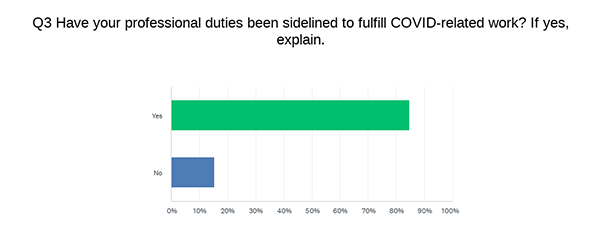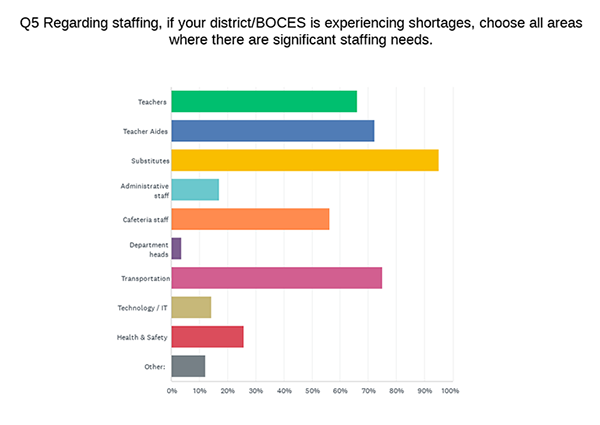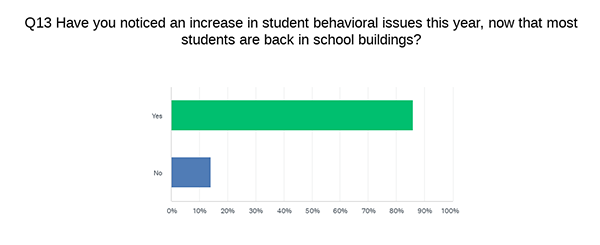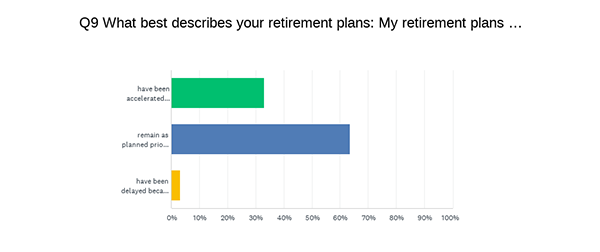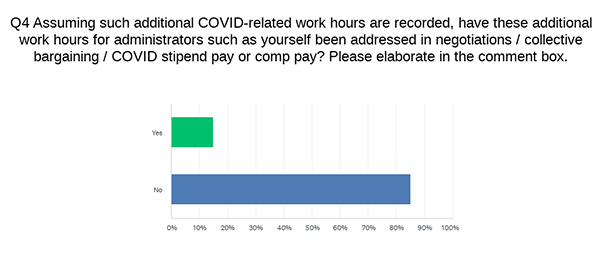SAANYS Survey on the Impact of COVID on School Administrators
Download additional summary data.
Survey on the Impact of COVID on School Administrators
“My family hasn’t seen me much in two years.”
So sums up the life of a school administrator during what has been an unprecedented time for students and the professionals responsible for far more than their education, but their social, emotional, and physical well-being as well.
There have been numerous studies on the impact of the pandemic on students, teachers, and many other professionals, but how are our school leaders faring? To find out, SAANYS recently conducted a survey of its members – school principals, assistant principals, directors, supervisors, and the various titles within the membership. Given the considerable number of responses returned (676) between January 31 and February 9, it was clear that members had a lot on their minds, sharing not only data but hundreds of comments and reflections.
It’s been A LOT
“I have become an honorary member of the health department. I have not focused on instruction or community building. I’m tired.”
The survey asked the question, “Have your professional duties been sidelined to fulfill COVID-related work?” The message was very clear with 85 percent reporting “yes,” their traditional school and educational roles indeed have taken question a backseat.
“We have become more medical directors than instructional leaders. With DOH and state ed continuously changing protocols, we are constantly meeting and making adjustments. The ability to get into classrooms and complete other professional responsibilities has been compromised, leading to higher levels of stress and anxiousness.”
“One area significantly impacted is the focus on teaching, learning, and instruction – fewer classroom visits and fewer instructionally-based conversations.”
Among the respondents, 75 percent hold the title of principal or assistant principal. And for these members, those in charge of all that it entails to run a school building and care for hundreds of students and staff – trying to keep up with it all simply means longer hours and very long days.
“Contact tracing took up so much time that the only way to stay somewhat afloat was to stay well past the end of the workday, bring work home and come in on weekends. I even did work while I was out myself with COVID – Google Meets, emails, paperwork, things had to get done.” These reflections and comments were common and showed the hard work and sacrifices being made by those on the frontlines not in hospitals, but in schools – “I worked Thanksgiving, Christmas Eve, Christmas Day, New Year’s Eve, New Year’s Day, all through Christmas break, and spent a trip with my son in my hotel room working.” Yes, school leaders are tired too.
A Top Stressor – Staffing
“We play the shell game every morning.”
One of those things consuming so much time and energy, and one of the top reported stressors, is staffing shortages. Commented one administrator, “I have been a 2nd grade teacher, 5th grade teacher, kindergarten teacher, and a custodian…all in one week.” He is not alone – 34 percent of respondents reported having to “often” or “very often” substitute in classrooms this school year due to staff shortages. As statewide infection numbers continue to decrease there is hope for some relief in this area. More than just hope, however, there were many comments from survey respondents suggesting expedited teacher preparation pathways as a way to get educators in classrooms sooner and shore up the teaching profession.
It is common knowledge that staffing shortages are not just in classrooms, [see chart below] and our transportation departments have been hit particularly hard. Seventy-five percent of respondents reported significant staffing needs in the area of transportation, higher than the 66 percent reporting teacher shortages. Said one member, “I work in transportation. I have office staff and mechanics driving daily.”
The Heart of the Matter
The other top stressor – the kids.
Beyond being responsible for plugging staffing holes, contact tracing, mask patrolling, and the analyzing of the ever-popular Friday memos from the Department of Health – SAANYS members are educators – no matter what one’s certification area, all are in the business of supporting students. That is why it is notable that 33 percent of respondents believe that certain populations of students under their supervision have experienced significant learning loss. Even more striking is that 28 percent believe that there has been significant learning loss across the general population.
However, respondents seem overwhelmingly concerned that students are struggling with far more than academics, noting the significant rise in students’ social emotional needs and behaviors. “The ability for our students to ‘cope’ and socialize with each other is noticeably different.”
“We are seeing a developmental delay in all students across the board. They tend to be about 1-2 years behind in their development. We have six-year-olds acting like preschool children throwing tantrums. Middle school kids are acting like elementary kids, and high school kids seem immature and act like middle school kids. And students are having mental health issues unlike those we’ve ever seen before.”
These “delays” were a common sentiment in the survey comments and particularly speak to the importance of in-person learning vs. remote according to one respondent: “The students who selected remote, or who were on remote for a significant portion of the school year, 2020-2021, are definitely immature, less resilient, and are displaying more at-risk behaviors (vaping, dress code/cell phone insubordination, etc.).”
In fact, a startling 86 percent of respondents reported an increase in student behavioral issues this year. “I think students have lost some academics but more have lost social and emotional learning that takes place within a school. I think students are struggling with values, morals, and what is appropriate in certain situations.” A number of respondents expressed anecdotally that more and more of the general population are also exhibiting signs of substance abuse. “Vaping is out of control,” observed one member.
Of course, subgroup populations are areas of increased concern for many:
- “[We have] students with significant disabilities who won’t wear masks with integrity or at all, are quarantined more frequently/longer, and can’t participate in remote learning/instruction, and lack of staffing keep [these] students from getting proper/required supports.”
- “Manifestation hearings are up 900% over last school year. (Yes… 900%)”
- “[There is] an increase in anxiety in higher achieving students.”
Reflecting on all of these issues, one respondent summed it up thoughtfully: “This is incredibly hard on all humans. It’s not behavior…it’s behavioral communication. Adults barely have the language to express the stressors of the current situation. Why should we expect students to be able to label it? We all just need to be patient, compassionate, and active listeners.”
Easing the Pain, A Bit
In an effort to do more than just tell the story of what administrators and schools have been going through during the past couple of years, this survey asked for feedback on what can be done now to move forward in a positive way. The question asked, “What legislative or policy action (state or local) would be most supportive to you at this time?”
Not surprisingly, there were some common threads among the top issues brought up among the 510 open comment-style responses to this question and most of those were related to COVID regulations and policies placed on schools. “The day in and day out changes without any prior notice was the most damning. By the time that we finally had a grasp on the ‘rules’, they changed the next day.”
And then there are the masks. “We need protection from the absolutely insane public that are attacking schools for doing what we’re being told to do by the governor.” In fact, masking came up frequently in survey comments, with over 80 respondents expressing support of loosening requirements for masks, eliminating the mask mandate, and/or creating an “off-ramp” for masking policies. Some comments were also telling about how the masking debate is draining school administrators in both a personal and professional way:
- “Legal threats and online harassment are exhausting, and we have no leverage to make it end.”
- “We are all being obliterated in BOE meetings from parents about masking.”
- “Abolish masking , abolish TTS, abolish contact tracing, and stop making the schools the battleground for these politics.”
- “End the mask mandate and distancing guidelines. Have a statewide end game. Do NOT leave decisions to local schools to deal with the brunt of the anger.”
Social distancing requirements hit a nerve as well among those surveyed. “Remove social distancing requirements – we have lost so much instructional space … we cannot continue to sustain this current model with current COVID requirements – staff and administration are going to crack.”
Again, concern for students’ social and emotional well-being was prevalent in these open-ended comments. “Cancellation of the New York State Regents examinations would send a message that the policymakers in Albany truly care about the social and emotional well-being of young people. Without this decision, we will be doing irreparable damage to students.” Concurred another colleague, “Remove assessments for students throughout the end of the year. There is much disruption to the learning process. We are holding them to the exact same standards and providing interrupted learning. Fewer teachers mean more subs, quarantines, and illnesses.”
Along the same line of regulations and mandates, there were many comments about again suspending the teacher and principal evaluations for the 2021-22 school year. Explained one respondent:
“The concept that APPR and accountability are still being held over our heads is unfathomable. This year has been significantly more of a drain than last year. Last year due to COVID restrictions we had fewer students in school on a daily basis. Yes, we had to navigate remote and in-person learning but the day-to-day tasks of managing a building were reduced since the number of students physically in the building were reduced. This year, there isn’t a remote option, so most students are present every day and those students have social and emotional issues that result in daily planning and support. Due to quarantine and isolation requirements keeping on top of attendance has been time consuming and supporting family needs has been paramount.”
State of the Profession
“We need incentives to stay in our positions, or…honestly…the whole thing is about to collapse. I don’t know a single administrator who isn’t thinking about balling it up and calling it a career.”
In fact, 33 percent of respondents indicated that their retirement plans have been accelerated because of the pandemic. Further, the data shows that 36 percent of all responding members plan on retiring within the next five years.
Perhaps in relation to plans of early retirement is the support that administrators are or are not getting from their district offices and supervisors. “We essentially were told we should be available 24/7. I’ve fielded calls, conducted contact tracing, and closed classes (contacted families, transportation, staff, etc…) all during nights and weekends.” Reports of two years of evening and weekend work were common among respondents, yet, when asked, have these additional work hours for administrators such as yourself been addressed in negotiations / collective bargaining / COVID stipend pay or comp pay?” – a resounding 85 percent reported, “No,” the consistent extra work has not been compensated for. Commented one respondent, “We attempted to get a stipend last year but our district denied it, which felt like a huge slap in the face.”
The Bottom Line
This survey of the SAANYS membership was telling. Our members are tired, overworked, and stressed about so much. Student mental health and wellbeing, academic supports, staffing shortages and morale, keeping up with ever-changing COVID rules and regulations, and the sheer time and energy it continues to take for school administrators to manage it all weighs heavily. “My own well-being is at the bottom of the list of things that get addressed,” said one administrator. “This includes the most basic of needs – eating right, sleeping right, managing stress often on my own.” The survey shows that school administrators are most definitely “Under Pressure” and need support from all levels, especially now, so that they in turn can support the many needs of their school communities. One respondent summed it up: “I would like to get back to the job of education, both with staff and students.”
